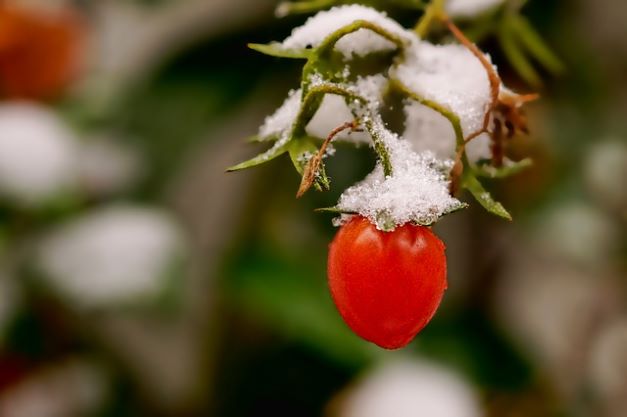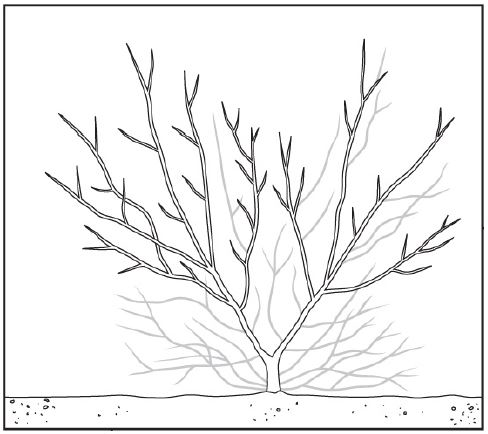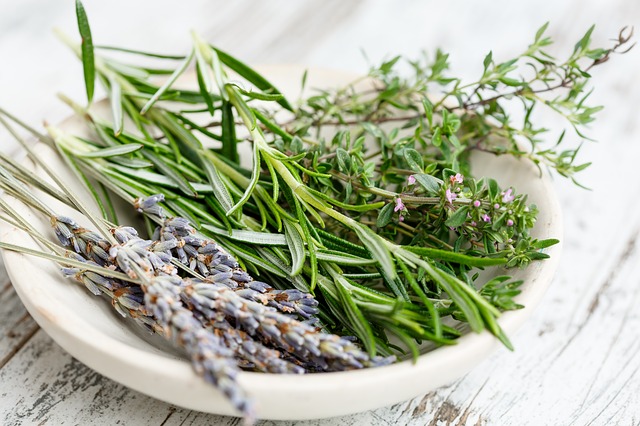
January is a good time to visualize your upcoming gardening season. Review your notes or photos from previous seasons, list crops you want to add/remove/move in your garden.
Maybe there is some sort of potato that brought good food to your table and you’d like to plant more of them. Maybe that fancy tomato you’ve grown last year doesn’t like the soil you worked hard to improve, so you’d rather find the one that is reliable and doesn’t need much hassle. Maybe you want to rearrange the placement of the beans so they receive more sunshine. Unleash your dreams and imagine a productive harvest that would be achieved with minimal (even lazy) efforts so that you delight in the fruits you like to eat most and can’t live without. And as you probably can’t take a soil sample now (like here in Zone 5B) I invite you to read my tips and tricks on how to feed yourself from your garden and from nature in January.FOOD GROWING CHORES*

- Plan your season from the practical point of view – Is there a crop you’d wish to enjoy over a longer span or just grab a momentary harvest? Think in advance: do you have the freedom to run succession planting and sow a short row of lettuce every two weeks or prefer to rely on long-standing heat-tolerant spinach?
- Check your leftover seeds and make a list of which ones you need before ordering more of them. It might be that you have enough of your own…
TIP: What if you make a twist in 2022 by stepping two generations back in thyme recovering the habit of preserving your own seeds and start creating your very first heirloom collection? When you collect the seeds you know they have a proven chance of surviving in your local climate. You’re certain about what kind of soil they thrive in. You observed from your own experience when they bloom and ripen up the fruit to give you a good harvest. If you are already receiving seed catalogs, use them as a learning tool.
- When it comes to fruit growing, this is the month to take a long, hard look at the shape of your fruit trees, as their silhouettes are at their most prominent now that the branches are bare. Winter pruning involves shaping your trees when they’re dormant and it’s never drastic in most cases. Mild January or February days are the best to tackle Apples and Pear trees.
TIP: It’s a good idea to take a picture of these summer-ripened trees in winter so that you can clearly see their shapes minus the foliage.
- Winter-prune Gooseberries. Cut back the leading stems by half. The side shoots (or laterals) have to be cut back to two buds. This encourages fruiting spurs to form on the old wood. Once this has been done, check that the framework of the bush is open enough and remove more wood if the crown seems congested. An open middle makes picking berries on a prickly bush easier.

TIP: If you have inherited an old fruit tree and it’s cropping well, leave it alone. However, if it’s in bad condition but you enjoy the fruit, it may be worth taking the time and trouble to rejuvenate it through pruning.
- Be sure to check stored vegetables – Potatoes, Carrots, Cabbage, Beets, Winter Squash, and others (“one bad apple…” and all that jazz, you know).
TIP: Make sure to keep your Garlic bulbs under room temperature. If you stored them in the cold room or cellar they might start shooting the greens, so now it’s time to freeze some, as whole cloves. Ditto with Onions if needed to keep them fresh, not sprouting. Or go further with fermenting, pickling, and preserving them to extend the storage time.
- Surprise your friends by harvesting Jerusalem Artichokes and Parsnips from the garden during a January thaw.
- Cover cold frames with a warm blanket on very cold nights. A piece of old carpet is an ideal alternative. Put it in place before the temperature drops, and remember to remove it the next morning unless it remains exceptionally cold. Your plants need light and warmth.
TIP: Winter mulch the beds where you grow berries and herbs. This way you prevent shallow-rooted or recently set-out perennials from heaving. Another function of winter mulch is to protect marginally hardy plants by reducing frost penetration. An 8-in layer of straw, shredded leaves or wood chips prevents the ground from freezing deeply. And used as the base of deep-rooted plants, it permits them to draw water from below the frost layer.
- Keep adding kitchen waste, mulch, wood chips, or any other type of natural materials to the garden. They will decompose much faster than in a compost pile. Weather and elements will collaborate to integrate all minerals and nutrients into the soil right in place without you moving a finger.
TIP: Don’t throw out storage onions when they start to sprout! Pot them up, and you can eat spicy greens all winter long. If you are a fan of houseplants, plant a couple of sprouted onions in with them, you will be harvesting deliciously crisp and mild onion greens in just a little more than a week. What’s more, they thrive in a window with low light, where little else will grow.
- Start a garden journal now, allowing space to mark the dates of first and last frosts, seed-planting dates, transplanting, time of bloom, first fruit, fertilizing, problems with pests, and what worked and didn’t work. Over a period of years, this will be an invaluable record.
And if you can’t wait, grow these veggies in January* :
- You probably shouldn’t start your vegetable seeds now, unless it’s for a cool-season crop and you live in a relatively warm zone. But you can still plan for upcoming activities in February when the time comes to sow Asparagus, Leeks, and, down below in herbs: Rosemary.
- Despite the natural state of dormancy that most plants undertake for the winter months, if you choose the correct varieties you can grow yummy veggies undercover or in a cold frame all winter long. Whether you really want to become a self-sustainable or only experiment to see if you can pull any veggies off during the cold winter, consider 6 hardy ones: Spinach, Kale, Chards, Broccoli, Celery, Leeks.
- Plant Lettuce in flats this month and harvest before it’s time to start some of the later seedlings. Artificial light may be required, but the air should not be too hot.
- Grow your own sprouts from the grains you already have in your possessions (buckwheat, green peas, beans for example)
HERBAL CHORES*

January, after the holidays are perfect to make fresh starts and new beginnings, especially for the food-growers who now have more thyme to spend in the kitchen enjoying the harvests from our summer gardens… our dried herbs!
To begin the New Year right, start your own herbal journal, to compile information as you learn it from any herbal book Santa brought to you, or from following @GardenHowTo 
- Visualize the lush greenery that will give you fresh seasonings and vitamins all summer and dried fragrance and flavor all winter. Dream about the herbs that will flavor your summer iced drinks, desserts, and cooked salads. Imagine the taste of fresh, pungent Basil intertwined with your garden tomatoes. Smell your favorite Peppermint that will provide a healthful winter tea next January.
- When you’re drawing your herbal garden on paper this month, consider how you can grow a variety of mints and keep them separated – intermingling will tend to weaken their unique flavors. I bet this principle is valid for all other herbs from the same family. It sounds the same as you would not mix more than one type of basil in a salad mix for example.
- Plan now to luxuriate next January by your wood stove or fireplace with a pot of your very own homegrown herb tea and a couple of your best friends – or a good herb book! Dream what tastes you want to feel in your teas and prepare to plant herbs that release those delicious tastes.

- Decide which perennial herbs you’re going to buy as plants vs which can be raised from seed.
- Make a sketch of the herb bed & place the plants, remembering their height when fully matured and sun, part shade, and other requirements. Pay attention to the location, space, size, and shape of your herb garden. Take the sun into account, your herbs will need that source of joy.
TIP: You can place individual perennial herbs among flower beds or along the walls of your house. Where a new herb bed is being started choose one facing South with protection from the North and East. Southern exposure is the best, but East and West facing areas that get a half-day of the sun will do for most herbs. Ideally plan to occupy the sloping bed.
- Some herbs though will be happy almost everywhere. Applemint, for example, will grow profusely on all four sides of your house, so if you have limited options you should save your sunniest spots for other sun-hungry herbs.
- Watch carefully the herbs you brought indoors for the winter tendering. Do not overwater but keep the soil moistened.
- Awaken the dreams of creating your own herbal mixes to flavor salads, soups, stews, bread, omelets, roasts, or poultry stuffings.

- Pamper yourself by taking leisurely herbal baths. Experiment with new scents that you create from your own mix of herbs, or plainly infuse one single herb without any additions. Soak in the warm airs and dream with me of the spring to come.
And if you feel itchy, grow these herbs in January*:
- Look for the seeds of Rosemary that you will sow in February.
- Plant Parsley seed under glass for an early crop, they take a long time to germinate anyway.
- Start slow-growing herbs (Rosemary, Sage, Oregano) from cuttings.
- Build a collection of scented Geranium (Pelargonium) by taking cuttings from a friend’s plants and starting them up.

FORAGING CHORES*
Calling all foraging enthusiasts….don’t stop foraging just because the snow falls! While walking or snowshoeing on a forest trail, notice that Mother Nature is holding the gifts for us in winter too. The food you wind in the wilderness is genetically stronger than cultivated food and more nutritious than hybridized store produce. You have more choices in the environment than the aisles of a regular supermarket.
As wild plants fight off the same organisms as your body when you are eating wild food you strengthen your immunity system.
Rub between your fingers and smell the leaves of the conifer trees, observe fallen dead trunks to see if there are any mushrooms to pick up, and ask birds to share some edible berries with you.
Here are some wild plants you can extract the seasonal flavors from in January* :
- Forage Turkey Tail mushrooms, they are hardy enough not to shrivel and tough to store the medicinal properties long into the winter.

- Collect sweetened by the frost Highbush Cranberry, also called guelder rose (Viburnum opulus) berries. The smell of its fresh fruits resembles the smell of valerian and apples at the same time, so they are not to everyone’s taste. But the bitterness decreases in frozen berries. If you’re turning your nose from eating these berries raw, bring them home and cover them with sugar. Brew viburnum tea with honey as a home remedy for coughs, colds, or fever. Viburnum berries increase heart rate, have a good effect on the kidneys, are useful in fighting multiple sclerosis and hypertension.
- This time of year is very convenient to gather Rose Hips. Thanks to the cold weather that dries them out, pick them up during the frost when they’re hard vs during warm days when they are dampened and could get squashed between your fingers right away. High in vitamin C and antioxidants, rose hips are wonderful for your immune system, and super soothing for your skin. There is so much you can do with these beauties: tea, syrup, cordial, and more!

- Enhance your meals with Juniper berries. January is the right season for picking them as they will drop down in February. Select only blue ones, as green ones could be new and not ripened yet, they will be ready next late fall and winter.

- Gather Pine Needles and brew syrup which is super helpful for calming coughs and soothing sore throats, so it’s definitely one you’ll want to have ready this season. Or infuse needles in vinegar, it will be your new salad dressing, why not! To get you started, know that all species in the Pinus genus are edible, but not all needles will taste great. So grab a bunch of needles and chew – if they taste great, grab them!

- Forage Cedar leaves to permeate your healing bath or brew profoundly potent cedar tea. Last time I grabbed a bunch of cedar leaves and pine needles, covered them with water, and let the mix simmer for 15 minutes. After turning off the heat I let the liquid stay with the greens overnight, so that the infusion process continues. When the liquid finally cools down it becomes quite a potent immune-boosting elixir. Here you go, a quick recipe for you!
I will conclude the January food growing calendar with the quote from Henry Mitchell’s article, Weather Soon Wither a Gardener’s Innocence:

*THE list of edibles to start on your own or forage in the wild and the TO-DO hints I offer in the chores will apply most anywhere–pruning a raspberry bush or sowing a pepper seed is similar, wherever the raspberry or tomato may grow. But the when is not the same. To help adjust the timing: I play with edibles in Zone 5B, in the Southern Ontario (York Region) area, where frost can persist well into May and surprise in October. If you’re North or South of me, you may apply next month’s chores, or last month’s (thank you for being patient while I’m planting out calendars for the remaining months 
P.S. I’d love to invite you to join my early waiting list to the GardenHowTo online community if you feel inclined.
CREDITS:
P.S. If this post has helped you in some way or if you have any further questions I’d love to hear from you. Feel free to reply with your comment below.



